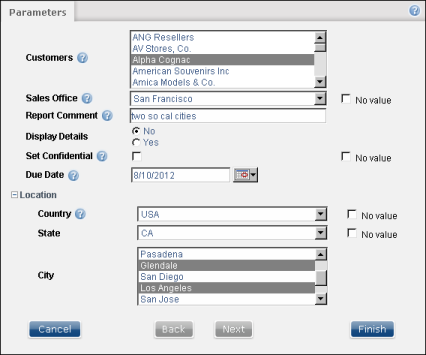An ad hoc parameter uses patterns to retrieve or filter data from a document’s data source. This data is then used by the document in its tables, charts, maps or other presentation formats built in to the document. Ad hoc parameters are supported for spreadsheet reports. They are not supported for BIRT reports.
Parameter choices depend on other parameters. For example, a parameter to select from a list of cities is empty until the country is selected first.
A multiple-value parameter accepts more than one value to filter the document data. For example, a report that provides sales information of products sold can request the user to select multiple products.
A user can select or group the data presented in a report by typing values or conditions into the optional parameter. If a user does not specify a value for an optional parameter, the document job uses a value chosen by the document designer.
A required parameter must have a value before the document job can run. For example, a report that accesses a database can require a user name and password or require a user to select a city before running a city report. Typically, a document designer supplies a default value for a required parameter.
A single-value parameter accepts one value to filter the document data. For example, a report that provides sales information by customer requires the user to select a customer from a list of existing customers.
The example in Figure 3-3 shows Parameters prompting input of values for several parameter types.
|
Figure 3-3
|

